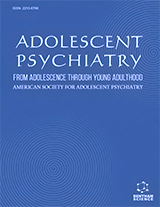Abstract
Background: Adolescent motherhood has been found to be associated with offspring suicidal behaviour in adolescence in a few cohort and general population studies.
Aims: To examine this association in a clinical adolescent population.
Method: As part of a continuing study on attempted suicide among adolescents in Northern Greece, 160 cases were examined and compared to a same size general clinical population (all diagnoses except attempted suicide). Comparisons were also made with general population data.
Results: The suicidal adolescents were statistically more likely to have been born to a teen mother or to a mother who gave birth to her first child before the age of twenty. We found that 16.3percent of the suicidal adolescents’ mothers were aged ≤19 at their suicidal offspring’s birth, while 34.4 percent were ≤19 at first childbirth. Corresponding rates in the general clinical population were 5.6% and 17.5% respectively. Rates of teen childbirth appear dramatically higher in the mothers of suicidal adolescents compared to those in the general population in Greece.
Conclusions: Our findings suggest that teenage motherhood should be studied more systematically in its association to offspring suicidal behaviour in adolescence.
Keywords: Adolescent suicide attempts, adolescent parenthood, risk factors
Adolescent Psychiatry
Title:Adolescent Parenthood and Offspring Suicide Attempts in Adolescence
Volume: 2 Issue: 4
Author(s): Nikos Zilikis, Tatiana Tairi, Grigoris Abatzoglou and Apostolos Iacovides
Affiliation:
Keywords: Adolescent suicide attempts, adolescent parenthood, risk factors
Abstract: Background: Adolescent motherhood has been found to be associated with offspring suicidal behaviour in adolescence in a few cohort and general population studies.
Aims: To examine this association in a clinical adolescent population.
Method: As part of a continuing study on attempted suicide among adolescents in Northern Greece, 160 cases were examined and compared to a same size general clinical population (all diagnoses except attempted suicide). Comparisons were also made with general population data.
Results: The suicidal adolescents were statistically more likely to have been born to a teen mother or to a mother who gave birth to her first child before the age of twenty. We found that 16.3percent of the suicidal adolescents’ mothers were aged ≤19 at their suicidal offspring’s birth, while 34.4 percent were ≤19 at first childbirth. Corresponding rates in the general clinical population were 5.6% and 17.5% respectively. Rates of teen childbirth appear dramatically higher in the mothers of suicidal adolescents compared to those in the general population in Greece.
Conclusions: Our findings suggest that teenage motherhood should be studied more systematically in its association to offspring suicidal behaviour in adolescence.
Export Options
About this article
Cite this article as:
Zilikis Nikos, Tairi Tatiana, Abatzoglou Grigoris and Iacovides Apostolos, Adolescent Parenthood and Offspring Suicide Attempts in Adolescence, Adolescent Psychiatry 2012; 2 (4) . https://dx.doi.org/10.2174/2210676611202040345
| DOI https://dx.doi.org/10.2174/2210676611202040345 |
Print ISSN 2210-6766 |
| Publisher Name Bentham Science Publisher |
Online ISSN 2210-6774 |
 10
10
- Author Guidelines
- Bentham Author Support Services (BASS)
- Graphical Abstracts
- Fabricating and Stating False Information
- Research Misconduct
- Post Publication Discussions and Corrections
- Publishing Ethics and Rectitude
- Increase Visibility of Your Article
- Archiving Policies
- Peer Review Workflow
- Order Your Article Before Print
- Promote Your Article
- Manuscript Transfer Facility
- Editorial Policies
- Allegations from Whistleblowers
- Announcements
Related Articles
-
Epigenetic Alterations in DNA and Histone Modifications Caused by Depression and Antidepressant Drugs: Lessons from the Rodent Models
Current Pharmaceutical Design The Cardiovascular and Cardiac Actions of Ecstasy and its Metabolites
Current Pharmaceutical Biotechnology A Comprehensive Review on Pistacia integerrima
Current Traditional Medicine CD45 Regulated Signaling Pathways
Current Topics in Medicinal Chemistry 6-Membered Pyrrololactams: An Overview of Current Synthetic Approaches to their Preparation
Current Organic Chemistry Comparative Modeling: The State of the Art and Protein Drug Target Structure Prediction
Combinatorial Chemistry & High Throughput Screening Sympathetic Nervous System, Genes and Human Essential Hypertension
Current Neurovascular Research Recent Advances in Cancer Therapy: An Overview
Current Pharmaceutical Design Application of Glutathione as Anti-Oxidative and Anti-Aging Drugs
Current Drug Metabolism The Orexinergic (Hypocretin) System and Nociception: An Update to Supraspinal Mechanisms
Current Medicinal Chemistry Development of Radioligands for In Vivo Imaging of Type 1 Cannabinoid Receptors (CB1) in Human Brain
Current Pharmaceutical Design Interactions of Iron Oxide Nanoparticles with the Immune System: Challenges and Opportunities for their Use in Nano-oncology
Current Pharmaceutical Design Rimonabant, Gastrointestinal Motility and Obesity
Current Neuropharmacology The Role of Glioma Microenvironment in Immune Modulation: Potential Targets for Intervention
Letters in Drug Design & Discovery Macrophage Colony-Stimulating Factor (M-CSF) in Plasma and CSF of Patients with Mild Cognitive Impairment and Alzheimers Disease
Current Alzheimer Research Exercise as a platform for pharmacotherapy development in cardiac diseases
Current Pharmaceutical Design Recent Advances in Selective μ-Opioid Ligands as Evaluated in Animal Models
Central Nervous System Agents in Medicinal Chemistry The Large and Growing Burden of Stroke
Current Drug Targets Peptide Immunotherapies in Type 1 Diabetes: Lessons from Animal Models
Current Medicinal Chemistry Chalcones Acting as Inhibitors of Cholinesterases, β-Secretase and β- Amyloid Aggregation and other Targets for Alzheimer’s Disease: A Critical Review
Current Medicinal Chemistry


























